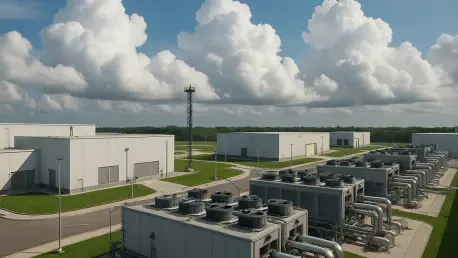Setting the Stage: The Digital Demand Surge
In an era where digital infrastructure powers everything from artificial intelligence to cloud computing, the electric utility sector faces a monumental shift. Data centers, the backbone of this digital revolution, are creating unprecedented electricity demand, with FirstEnergy, a leading utility in the PJM Interconnection region, projecting a staggering 45% increase in system peak load from 33.5 GW currently to 48.5 GW by 2035. This surge is not just a statistic; it represents a fundamental reshaping of energy consumption patterns. This market analysis examines how data centers are influencing FirstEnergy’s strategic direction, financial outlook, and operational priorities in the current landscape, shedding light on broader implications for the utility industry.
Market Trends and Strategic Responses
Data Centers as a Growth Engine
The rapid proliferation of data centers stands as a defining trend for FirstEnergy, with the company already securing 3.8 GW of contracted load and identifying an additional 11.7 GW in potential demand within its service territory. This growth trajectory signals a shift in load composition, heavily weighted toward industrial consumption driven by technological needs. Unlike traditional demand drivers like population growth, this digital boom requires utilities to adapt at an accelerated pace, pushing FirstEnergy to rethink capacity planning and grid reliability to meet the needs of high-energy clients without compromising service to existing customers.
Transmission Infrastructure: A Critical Investment Focus
To support this escalating demand, FirstEnergy has committed $14 billion to transmission projects within a broader $28 billion capital expenditure plan spanning from now to 2029. This investment is underpinned by an expected compound annual growth rate of up to 18% in its transmission rate base through 2030, positioning transmission as a cornerstone of growth. Across the PJM region, peak load is anticipated to rise by 30% over the next decade, highlighting a shared challenge that validates FirstEnergy’s focus on grid expansion. The emphasis on connectivity over generation upgrades sets the company apart from peers, though regulatory hurdles and potential cost overruns remain risks to monitor.
Electric Sales Shifts and Industrial Dominance
Current electric sales trends reveal a modest 1% uptick in the first nine months of the year compared to last, though weather-adjusted figures show no significant change. However, the industrial sector, fueled by data center activity, is poised for robust growth, with mid-single-digit increases expected by mid-next year and even steeper rises by year-end. This pivot toward industrial load dominance underscores a broader market evolution where utilities must recalibrate their operational models to prioritize high-density energy users, potentially reshaping revenue streams and resource allocation in the near term.
Financial Performance Amid Rising Demand
Financially, FirstEnergy reported a net income of $441 million for the third quarter, marking a 5.3% increase year-over-year, bolstered by rate adjustments in key markets like Pennsylvania. The company also revised its capital expenditure estimate upward by 10% to $5.5 billion for the year, reflecting a strong commitment to infrastructure amid digital demand pressures. This financial stability provides a foundation for growth, yet it also highlights the balancing act between reinvesting profits and managing stakeholder expectations in a high-investment environment.
Customer Affordability Challenges in a Competitive Market
Despite financial gains, rising utility bills pose a significant market concern, with an average 11% increase in deregulated states over the past year, largely driven by generation costs. FirstEnergy is actively pushing for reforms in PJM capacity auctions, proposing a two-tiered pricing structure to protect consumers from costs tied to undelivered new capacity. This tension between funding infrastructure for data centers and maintaining affordability for residential and commercial customers reflects a broader industry challenge, where market dynamics and regulatory frameworks must evolve to ensure equitable cost distribution.
Future Capacity Planning with Gas-Fired Generation
Looking to secure reliable power for future demand, FirstEnergy plans to develop 1.2 GW of gas-fired generation in West Virginia, targeting an in-service date of 2031 at an estimated cost of $2.5 billion. The company is exploring both developer partnerships and self-build options, demonstrating flexibility in execution. With supply chain lead times for major equipment improving to three to four years, there is cautious optimism for meeting project timelines, though this initiative also signals the ongoing reliance on fossil fuels to balance the baseload needs of data centers against sustainability goals.
Reflecting on the Market Dynamics
Looking back, the analysis of FirstEnergy’s position in the current market revealed a utility sector transformed by the rise of data centers, which drove a projected 45% peak load increase over the next decade. Financial stability, marked by a 5.3% net income growth, stood alongside significant investments in transmission and generation capacity, while affordability challenges underscored the complexities of this digital energy boom. For industry stakeholders, the next steps involve accelerating smart grid technologies to enhance resilience, fostering partnerships with data center operators for shared infrastructure funding, and advocating for market reforms to balance costs. These strategies offer a pathway to not only navigate but also capitalize on the evolving landscape, ensuring that utilities like FirstEnergy can lead in powering a digital future.









